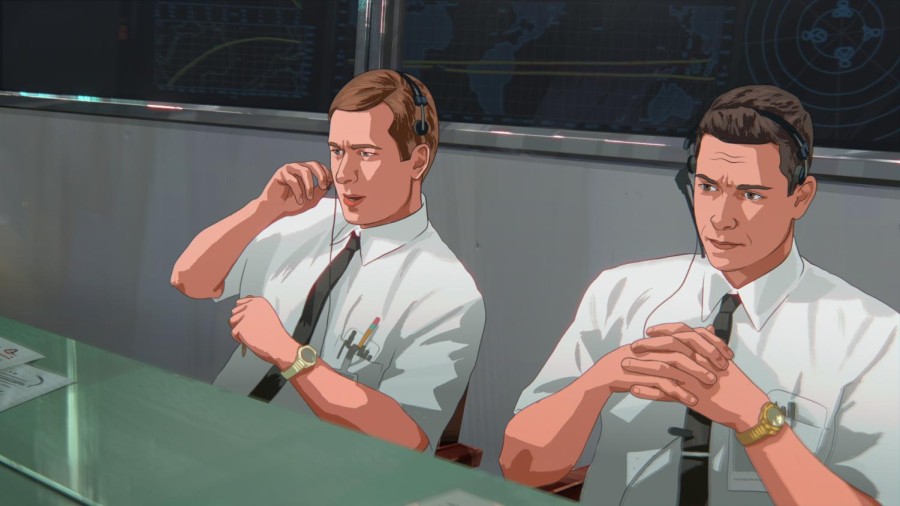Review: ‘Apollo 10 ½’ is a relaxing coming-of-age sci-fi film
Quietly released on Netflix, Richard Linklater’s latest film uses animation to capture the wonder of childhood.
Experimental plots combining non sequitur storylines through animation encapsulates the genius of “Apollo 10 ½: A Space Age Childhood,” the latest animation film by Richard Linklater. (Image courtesy of Netflix)
April 11, 2022
Richard Linklater’s films have always been less about the plot and more about the details. From his work on “Dazed and Confused” to “The Before Trilogy,” Linklater is the master of films where people hang out — the attention to the details in what they do being what elevates his films beyond being tossed off as aimless.
With his latest gem, “Apollo 10 ½: A Space Age Childhood,” Linklater remains true to this style, despite promotional material suggesting a more high-concept storyline. Google may label the film as ‘science fiction/adventure’ and the poster may showcase its main character in a spacesuit, but make no mistake, Stan’s adventures include space travel just as much as they do biking around with friends.
Voiced by Jack Black, Stan narrates stories of his childhood in late1960s Houston, where the Space Race informs the city’s culture. The latest and greatest in man-made technology was all there, from spaceships to button-dial phones.
One day in 1969, 10-year-old Stan is taken aside by two men in suits, Kranz (Zachary Levi) and Bostick (Glen Powell), who have a proposition for him. They’ve accidentally made an Apollo spacecraft too small for adults, so they want him to take it to space for them. Fascinated by this unusual proposition, Stan agrees — a standard decision in an era when kids idolized Neil Armstrong rather than Elon Musk.
In a subversive choice of plotting, this Space Race-based fantasy plotline takes a backseat for nearly the first hour of the film. Instead, Linklater observes Stan do what kids do and what he captures on film best: hanging out.
Reflecting on the way in which we retell memories, which aren’t always set perfectly in time and place, older Stan recalls the various activities that he, his friends and his family would get up to. In between trips to bowling alleys, arcades and beaches, Stan’s mom mocks hippies, his dad drives tipsy and his Grandma spouts conspiracy theories about John F. Kennedy.
There’s hardly a strong sense of progression between these memories, but that doesn’t matter because the audience is drawn into their familiarity and warmth. It feels nice to simply be invited to share them with Stan. This is due in part to the atmosphere that Linklater creates. Like his other films, the soundtrack is excellent. It further seeps the viewer in the era with tracks from big names like Donovan and Pink Floyd as well as deeper cuts that would only be known by someone who grew up in the 1960s.
When the Space Race does come back into play, it is woven seamlessly with Stan’s memories of his suburban childhood. Linklater knows how to intercut stories but simply didn’t want to at first. This is where the film’s choice of rotoscoping, a form of animation based on filmed actors’ movements, lends itself to an easy transition into the film’s sci-fi elements.
Whereas a live-action film might have cast Stan’s experiences as surreal, an animated film using rotoscoping allows Linklater to capture a sense of childlike wonder while maintaining a consistent tone. The animation already removes the audience from reality to a degree, making the space travel scenes feel similar in that they only slightly divert from reality, but not enough so that it distracts or disengages viewers.
The greatest example of this is when the Moon landing takes place, with Stan in orbit and his family in the living room gathered around the TV. His family experiences the magnitude of the moment, as does Stan, with the viewer getting the most pleasure in getting to be with both and know more than either.
Aided by the animation style, the Moon landing feels like a dream come true. As much as it was a dream realized for people to see the first man on the Moon, it is pure wish fulfillment for Stan to be able to go to Space. Stan’s family sees something out of this world as the young boy descends the ladder onto the lunar surface, and the film’s animation allows it to seamlessly transition to Stan’s perspective as he takes those great steps for mankind.
Linklater’s choice to fill the runtime of a Space movie with so many scenes of kids hanging out may seem counterintuitive, and some viewers might be resistant to this plotting. To reject this structure wouldn’t consider the ways in which it benefits the film and the ideas Linklater wishes to convey.
In front-loading the details of a late 1960s Houston childhood, Linklater makes the point that childhood wonder doesn’t pick favorites. For example, building forts out of plywood is the same kind of fantasy play that preparing for the flight does. Advancement of technology such as a non-rotary phone is as fascinating to the kids as the spaceships, if not more so, because it has a more direct impact on their lives.
It’s quite a subversive approach to make a film about the Space Race in which the race itself doesn’t take up the majority of the runtime. Viewers come in with a certain set of expectations and instead are reminded what it feels like to be a kid filled with wonder again. It is a welcome surprise.
Contact Sebastian Zufelt at [email protected].
























































































































































